Hydrogen Assisted Cracking in Pearlitic Steel Rods: The Role of Residual Stresses Generated by Fatigue Precracking
Abstract
:1. Introduction
2. Numerical Modelling
3. Residual Stress Distributions in Fatigue Precracked Rods
4. Hydrogen Distributions in Fatigue Precracked Rods
5. Conclusions
Acknowledgments
Author Contributions
Conflicts of Interest
Abbreviations
| BCC | Body centered cubic |
| CERT | Constant extension rate tension |
| CT | Crack tip |
| CTOD | Crack tip opening displacement |
| FE | Finite element |
| HAC | Hydrogen assisted cracking |
| HAF | Hydrogen assisted fracture |
| HE | Hydrogen embrittlement |
| LAD | Localized anodic dissolution |
| SCC | Stress corrosion cracking |
| SIF | Stress intensity factor |
| UTS | Ultimate tensile stress |
| a | Crack length |
| b0 | Crack tip initial half-width |
| bt | Current (deformed) crack tip half-width |
| [C] | Vector of the FE nodal values of hydrogen concentration |
| C | Hydrogen concentration |
| C0 | Hydrogen concentration in the metal free of stress in equilibrium with hydrogenating environment |
| Ceq | Hydrogen concentration in equilibrium state in stressed metal |
| d | Specimen diameter |
| D | Hydrogen diffusion coefficient |
| E | Young modulus |
| [F] | Assembled FE boundary condition matrix |
| i | Counter |
| J | Hydrogen flux vector |
| Jf | Hydrogen flux on the surface Sf |
| K | Stress intensity factor (SIF) |
| KIC | Fracture toughness |
| Kmax | Maximum SIF at cyclic loading |
| Kmin | Minimum SIF at cyclic loading |
| KR | Critical SIF at CERT test final fracture |
| [K] | Assembled FE diffusivity matrix |
| [M] | Assembled FE capacity matrix |
| n | Number of FE nodes |
| Ni | FE nodal functions |
| rp | Characteristic size of the plastic zone |
| R | Universal gas constant |
| RK | Load ratio |
| S | Specimen surface |
| Seq | Specimen surface exposed to the hydrogenating source |
| Sf | Specimen surface with a flux boundary condition imposed |
| t | Time |
| tq | Time corresponding to the increment q in numerical integration |
| tR | Final fracture time by hydrogen assisted cracking |
| T | Absolute temperature |
| ux,i | Deformation displacement of node i in x axis direction |
| uy,i | Deformation displacement of node i in y axis direction |
| vH | Partial molar volume of hydrogen in metal |
| V | Volume |
| x | Cartesian coordinate along the crack plane originating at the CT |
| y | Cartesian coordinate normal to the crack plane originating at the CT |
| δt | Crack tip opening displacement (CTOD) |
| ΔK | Amplitude of the stress intensity factor (SIF) during fatigue preloading |
| ΔKth | Fatigue crack propagation threshold |
| εeq | Equivalent strain |
| ϑ | Mass exchange constant on metal-environment surface |
| σ | Hydrostatic stress |
| σeq | Equivalent stress |
| σR | Ultimate tensile stress (UTS) |
| σY | Yield strength |
| τ | Stability factor in numerical integration scheme |
References
- Toribio, J.; Ovejero, E. Failure analysis of cold drawn prestressing steel wires subjected to stress corrosion cracking. Eng. Fail. Anal. 2005, 12, 654–661. [Google Scholar] [CrossRef]
- Zhao, W.; Xin, R.; He, Z.; Wang, Y. Contribution of anodic dissolution to the corrosion fatigue crack propagation of X80 steel in 3.5 wt. % NaCl solution. Corros. Sci. 2012, 63, 387–392. [Google Scholar] [CrossRef]
- Toribio, J.; Lancha, A.M. Stress corrosion behaviour of high-strength steel: Design on the basis of the crack growth kinetics curve. Mater. Des. 1996, 16, 283–288. [Google Scholar] [CrossRef]
- Toribio, J.; Elices, M. Influence of residual stresses on the hydrogen embrittlement susceptibility of prestressing steels. Int. J. Solids Struct. 1991, 28, 791–803. [Google Scholar] [CrossRef]
- Rimoli, J.J.; Ortiz, M.A. Three-dimensional multiscale model of intergranular hydrogen-assisted cracking. Phil. Mag. 2010, 90, 2939–2963. [Google Scholar] [CrossRef]
- De Meo, D.; Diyaroglu, C.; Zhu, N.; Oterkus, E.; Siddiq, M.A. Modelling of stress-corrosion cracking by using peridynamics. Int. J. Hydrogen Energy 2016, 41, 6593–6609. [Google Scholar] [CrossRef]
- Olden, V.; Thaulow, C.; Johnsen, R.; Østby, E.; Berstad, T. Application of hydrogen influenced cohesive laws in the prediction of hydrogen induced stress cracking in 25% Cr duplex stainless steel. Eng. Fract. Mech. 2008, 75, 2333–2351. [Google Scholar] [CrossRef]
- Toribio, J.; González, B.; Matos, J.C.; Ayaso, F.J. Fatigue performance of cold drawn prestressing steel: The effect of sudden load changes. Procedia Eng. 2011, 10, 3546–3551. [Google Scholar] [CrossRef]
- Ochiani, S.; Yoshinaga, S.; Kikuta, Y. Formulation of stress (strain)-induced diffusion of hydrogen and its solution by computer-aided finite-element method. Trans. Iron Steel Inst. Jpn. 1975, 15, 503–507. [Google Scholar]
- Häring, M. A seminumerical method to determine the depth profile of the three dimensional residual stress state with X-ray diffraction. Acta Mater. 1998, 46, 1427–1436. [Google Scholar] [CrossRef]
- Aguado, L. Papel de la carga cíclica y del ambiente en la fractura de acero perlítico trefilado. Ph.D. Thesis, University of Salamanca, Zamora, Spain, 2016. (In Spanish). [Google Scholar]
- Toribio, J.; González, B.; Matos, J.C. Strength anisotropy and mixed mode fracture in heavily drawn pearlitic steel. Fatigue Fract. Eng. Mater. Struct. 2013, 36, 1178–1186. [Google Scholar] [CrossRef]
- Toribio, J.; Matos, J.C.; González, B. A macro- and micro-approach to the anisotropic fatigue behaviour of hot-rolled and cold-drawn pearlitic steel. Eng. Fract. Mech. 2014, 123, 70–76. [Google Scholar] [CrossRef]
- Vasudevan, A.K.; Sadananda, K.; Glinka, G. Critical parameters of fatigue damage. Int. J. Fatigue 2001, 23, S39–S53. [Google Scholar] [CrossRef]
- Shin, C.S.; Cai, C.Q. Experimental and finite element analyses on stress intensity factors of an elliptical surface crack in a circular shaft under tension and bending. Int. J. Fracture 2004, 129, 239–264. [Google Scholar] [CrossRef]
- Toribio, J.; Kharin, V. Finite-deformation analysis of the crack-tip fields under cyclic loading. Int. J. Solids Struct. 2009, 46, 1937–1952. [Google Scholar] [CrossRef]
- Smialowski, M. Hydrogen in Steel; Pergamon Press: Oxford, UK, 1962; p. 452. [Google Scholar]
- Xu, K. Hydrogen embrittlement of carbon steels and their welds. In Gaseous Hydrogen Embrittlement of Materials in Energy Technologies; Gangloff, R.P., Somerday, B.P., Eds.; Woodhead Publishing: Oxford, UK, 2012; Volume 1, pp. 526–561. [Google Scholar]
- Stashchuk, M.H.; Dorosh, M.I. Evaluation of stresses caused by hydrogen concentrated in the metal. Mater. Sci. 2016, 51, 520–529. [Google Scholar] [CrossRef]
- Suresh, S. Fatigue of Materials; Cambridge University Press: Cambridge, UK, 1991. [Google Scholar]
- Tvergaard, V. On fatigue crack growth in ductile materials by crack-tip blunting. J. Mech. Phys. Solids 2004, 52, 2149–2166. [Google Scholar] [CrossRef]
- Toribio, J.; Kharin, V. Simulations of fatigue crack growth by blunting–re-sharpening: Plasticity induced crack closure vs. alternative controlling variables. Int. J. Fatigue 2013, 50, 72–82. [Google Scholar] [CrossRef]
- Gortemaker, P.C.M.; de Pater, C.; Spiering, R.M.E.J. Near-crack tip finite strain analysis. In Advances in Fracture Research, Proceedings of the Fifth International Conference on Fracture, Cannes, France; Pergamon Press: Oxford, UK, 1981; Volume 1, pp. 151–160. [Google Scholar]
- Liu, N.; Drugan, W.J. Finite deformation finite element analyses of tensile growing crack fields in elastic–plastic material. Int. J. Fracture 1993, 61, 189–210. [Google Scholar] [CrossRef]
- McMeeking, R.M. Finite deformation analysis of crack tip opening in elastic–plastic materials and implications for fracture. J. Mech. Phys. Solids 1977, 25, 357–381. [Google Scholar] [CrossRef]
- McMeeking, R.M.; Parks, D.M. On criteria of J-dominance of crack-tip fields in large-scale yielding. In Elastic–Plastic Fracture; ASTM STP 668; American Society for Testing and Materials: West Gonshohocken, PA, USA, 1979; Volume 1, pp. 175–194. [Google Scholar]
- Needleman, A.; Tvergaard, V. Crack-tip stress and deformation fields in a solid with vertex on its yield surface. In Elastic–Plastic Fracture: Second Symposium; ASTM STP 803; American Society for Testing and Materials: West Gonshohocken, PA, USA, 1983; Volume 1, pp. 80–115. [Google Scholar]
- Toribio, J.; Kharin, V. Role of fatigue crack closure stresses in hydrogen assisted cracking. In Advances in Fatigue Crack Closure Measurement and Analysis; ASTM STP 1343; American Society for Testing and Materials: West Gonshohocken, PA, USA, 1999; Volume 2, pp. 440–458. [Google Scholar]
- Deshpande, V.S.; Needleman, A.; van der Giessen, E. A discrete dislocation analysis of near-threshold fatigue crack growth. Acta Mater. 2001, 49, 3189–3203. [Google Scholar] [CrossRef]
- Broek, D. The Practical Use of Fracture Mechanics; Kluwer Academic Publishers: Boston, MA, USA, 1988. [Google Scholar]
- Sadananda, K.; Vasudevan, A.K. Crack tip driving forces and crack growth representation under fatigue. Int. J. Fatigue 2004, 26, 39–47. [Google Scholar] [CrossRef]
- Stoychev, S.; Kujawski, D. Analysis of crack propagation using ΔK and Kmax. Int. J. Fatigue 2005, 27, 1425–1431. [Google Scholar] [CrossRef]
- Zhang, J.; Je, X.D.; Du, S.Y. Analyses of the fatigue crack propagation process and stress ratio effects using the two parameter method. Int. J. Fatigue 2005, 26, 39–47. [Google Scholar] [CrossRef]
- Toribio, J. Fractographic evidence of hydrogen transport by diffusion in pearlitic steel. J. Mater. Sci. Lett. 1992, 11, 1151–1153. [Google Scholar] [CrossRef]
- Toribio, J. Hydrogen-plasticity interactions in pearlitic steel. A fractographic and numerical study. Mater. Sci. Eng. 1996, 219, 180–191. [Google Scholar] [CrossRef]
- Toribio, J. Role of hydrostatic stress in hydrogen diffusion in pearlitic steel. J. Mater. Sci. 1993, 28, 2289–2298. [Google Scholar] [CrossRef]
- Toribio, J.; Kharin, V. Evaluation of hydrogen assisted cracking: The meaning and significance of the fracture mechanics approach. Nucl. Eng. Des. 1998, 182, 149–163. [Google Scholar] [CrossRef]
- Toribio, J.; Kharin, V. A hydrogen diffusion model for applications in fusion nuclear technology. Fusion Eng. Des. 2000, 51–52, 213–218. [Google Scholar] [CrossRef]
- Enos, D.G.; Scully, J.R. A critical-strain criterion for hydrogen embrittlement of cod-drawn, ultrafine pearlitic steel. Metall. Mater. Trans. A 2002, 33, 1151–1166. [Google Scholar] [CrossRef]
- Toribio, J.; Kharin, V.; Vergara, D.; Lorenzo, M. Two-dimensional numerical modelling of hydrogen diffusion assisted by stress and strain. Adv. Mater. Res. 2010, 138, 117–126. [Google Scholar] [CrossRef]
- Shewmon, P.G. Hydrogen attack of carbon steel. Metall. Trans. A 1976, 7, 279–286. [Google Scholar] [CrossRef]
- Zienkiewicz, O.C.; Wood, W.L.; Hine, N.W.; Taylor, R.L. A unified set of single step algorithms. Part 1: general formulation and applications. Int. J. Numer. Meth. Eng. 1984, 20, 1529–1552. [Google Scholar] [CrossRef]
- Toribio, J.; Lancha, A.M. Effects of cold drawing on susceptibility to hydrogen embrittlement of prestressing steel. Mater. Struct. 1993, 26, 30–37. [Google Scholar] [CrossRef]
- Toribio, J. Role of crack-tip residual stresses in stress corrosion behavior of prestressing steel. Constr. Build. Mater. 1998, 12, 283–287. [Google Scholar] [CrossRef]

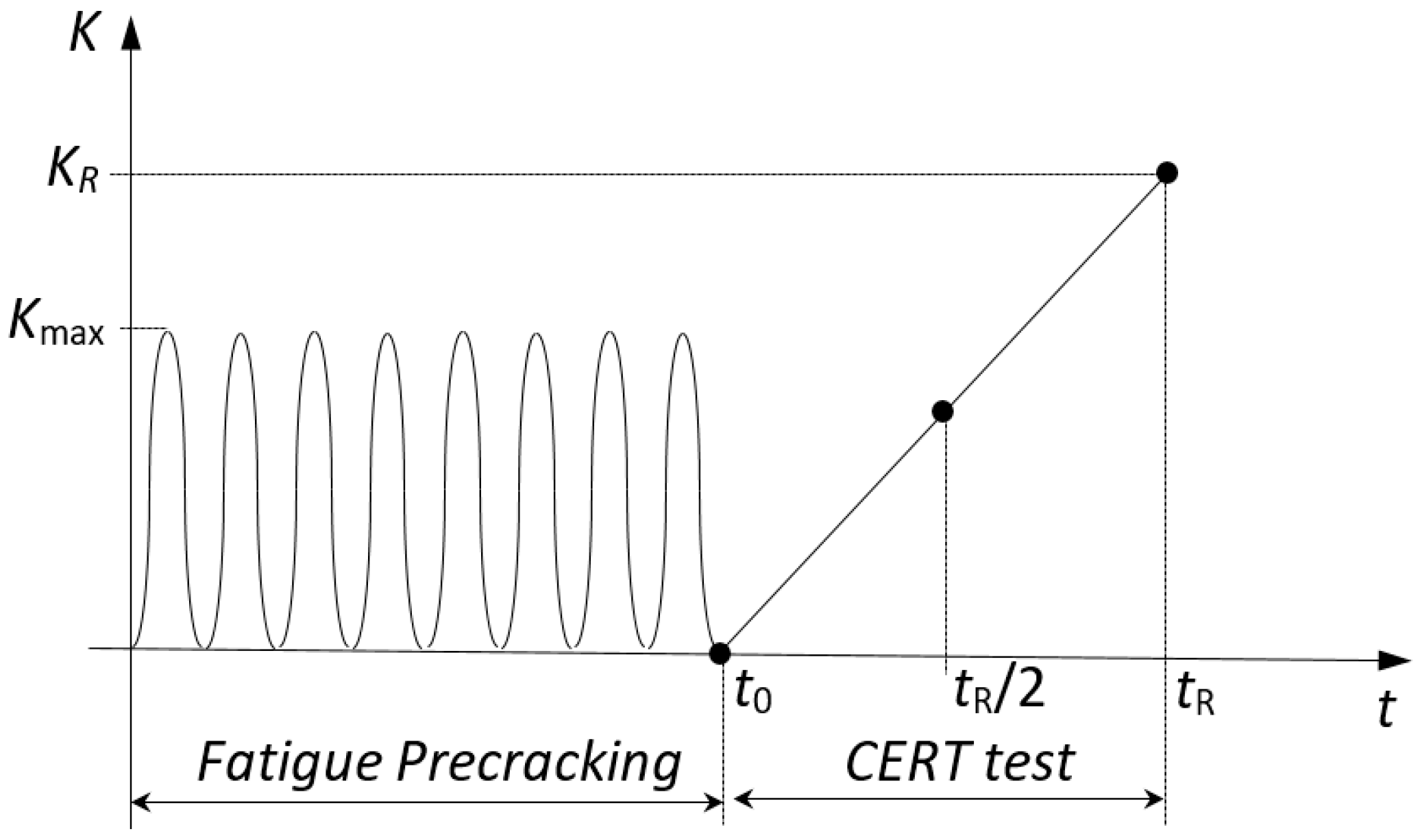
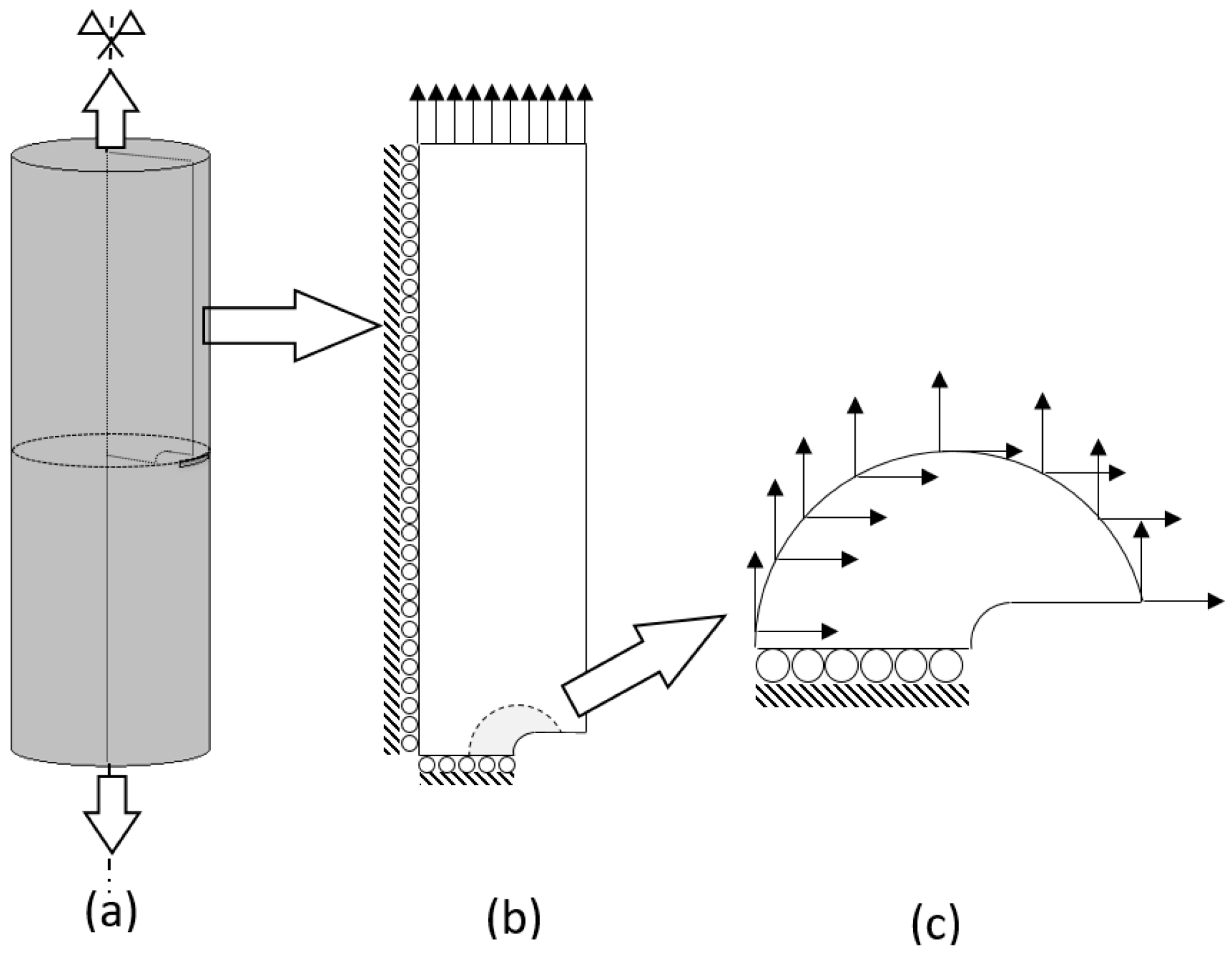
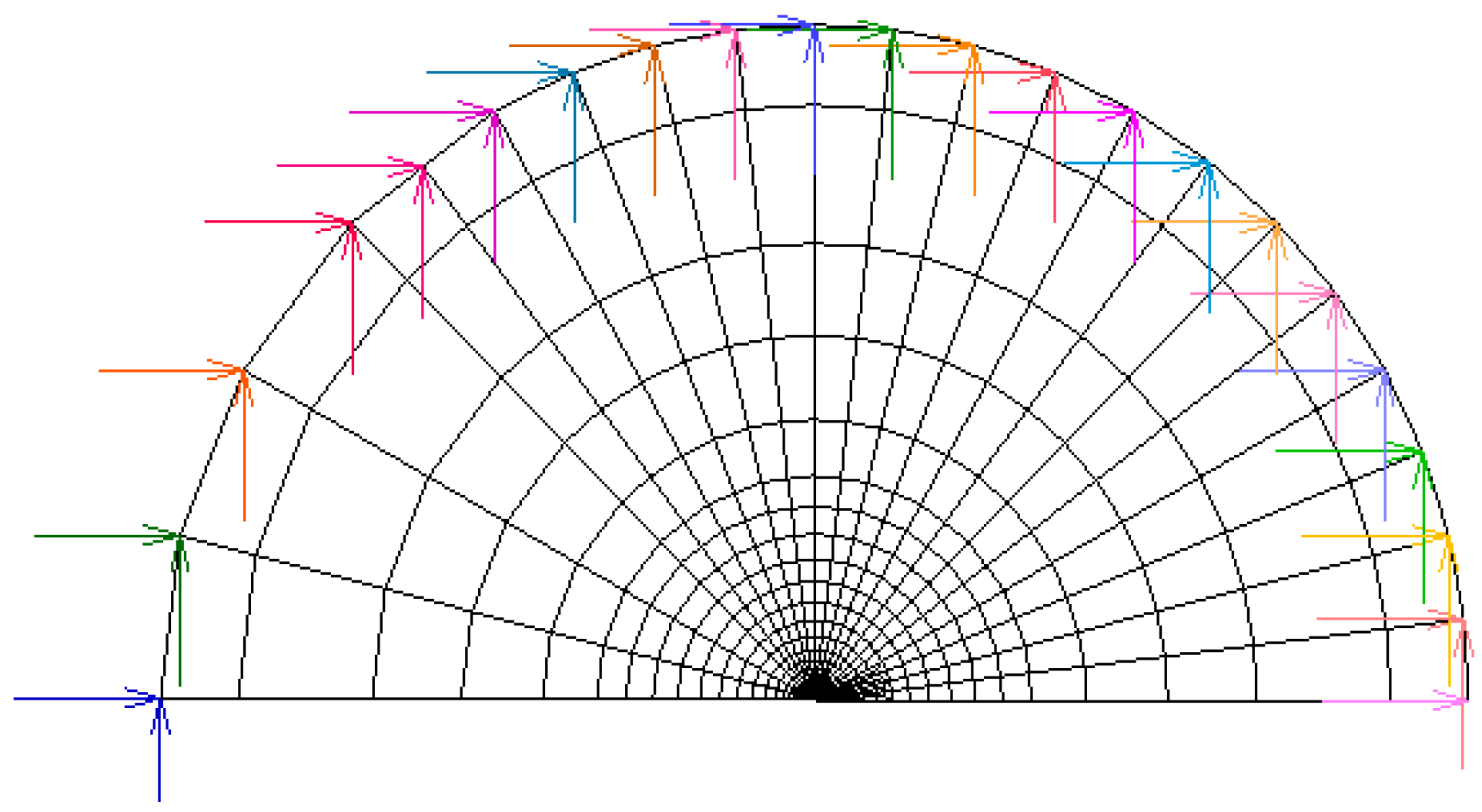
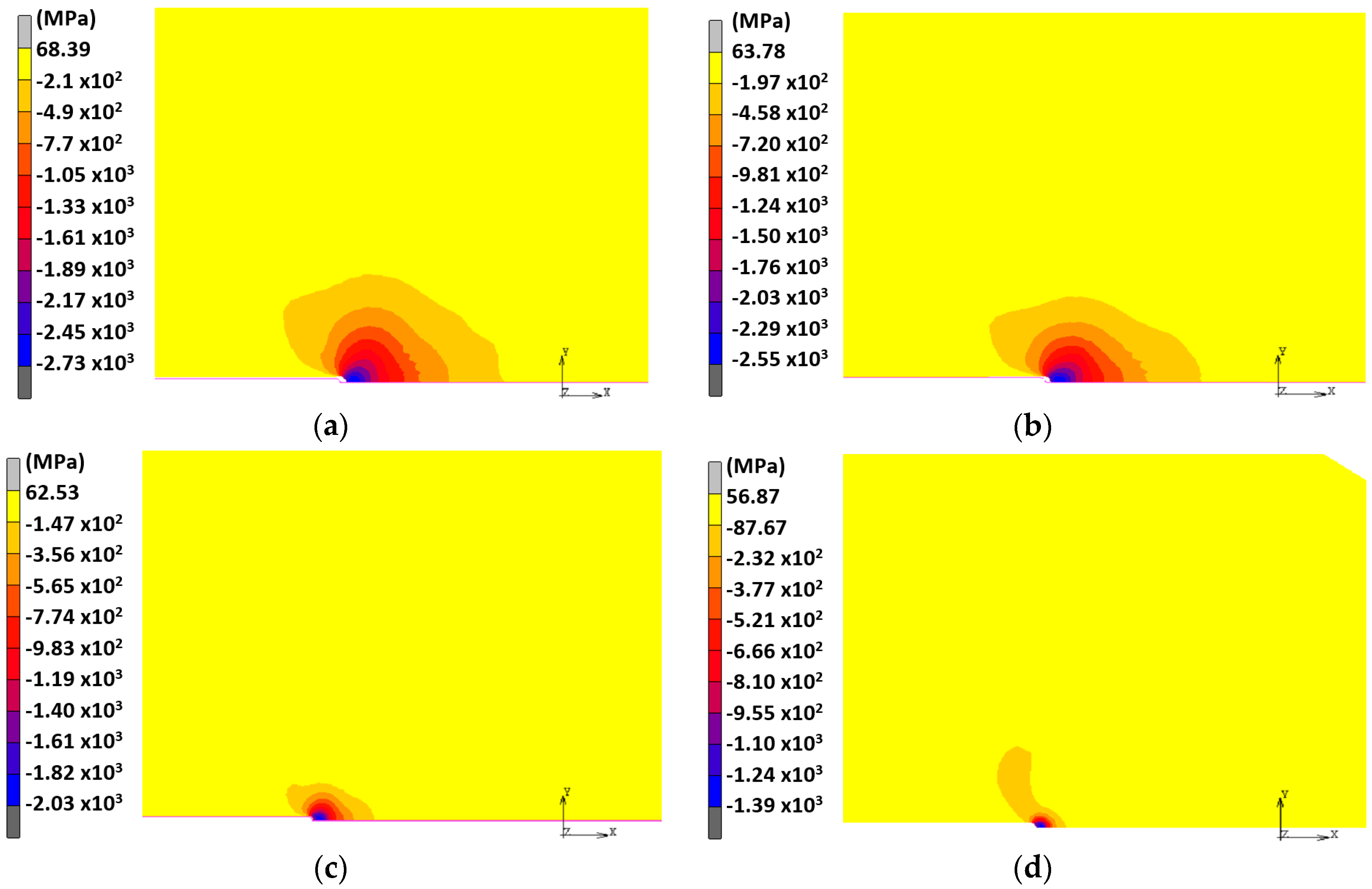
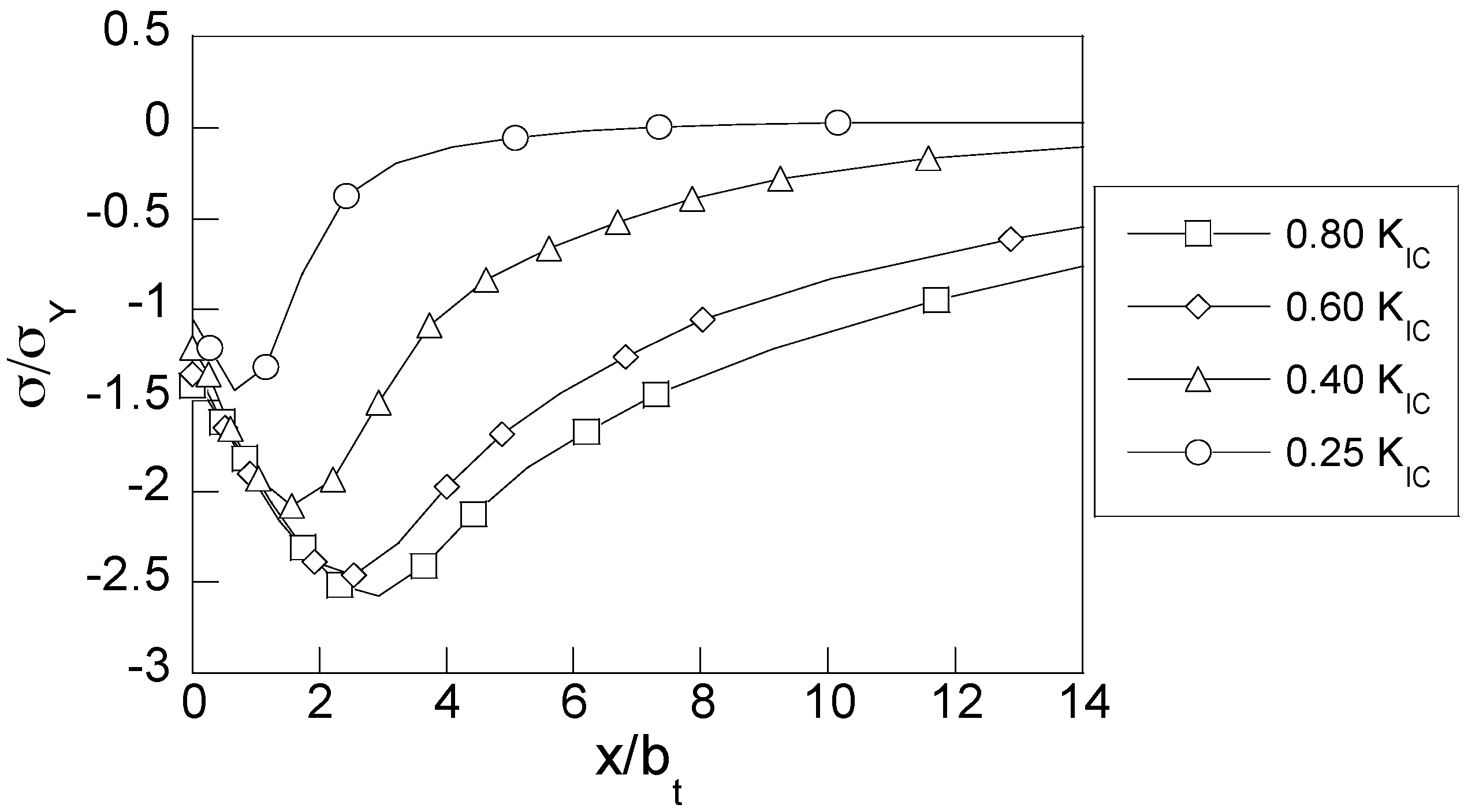
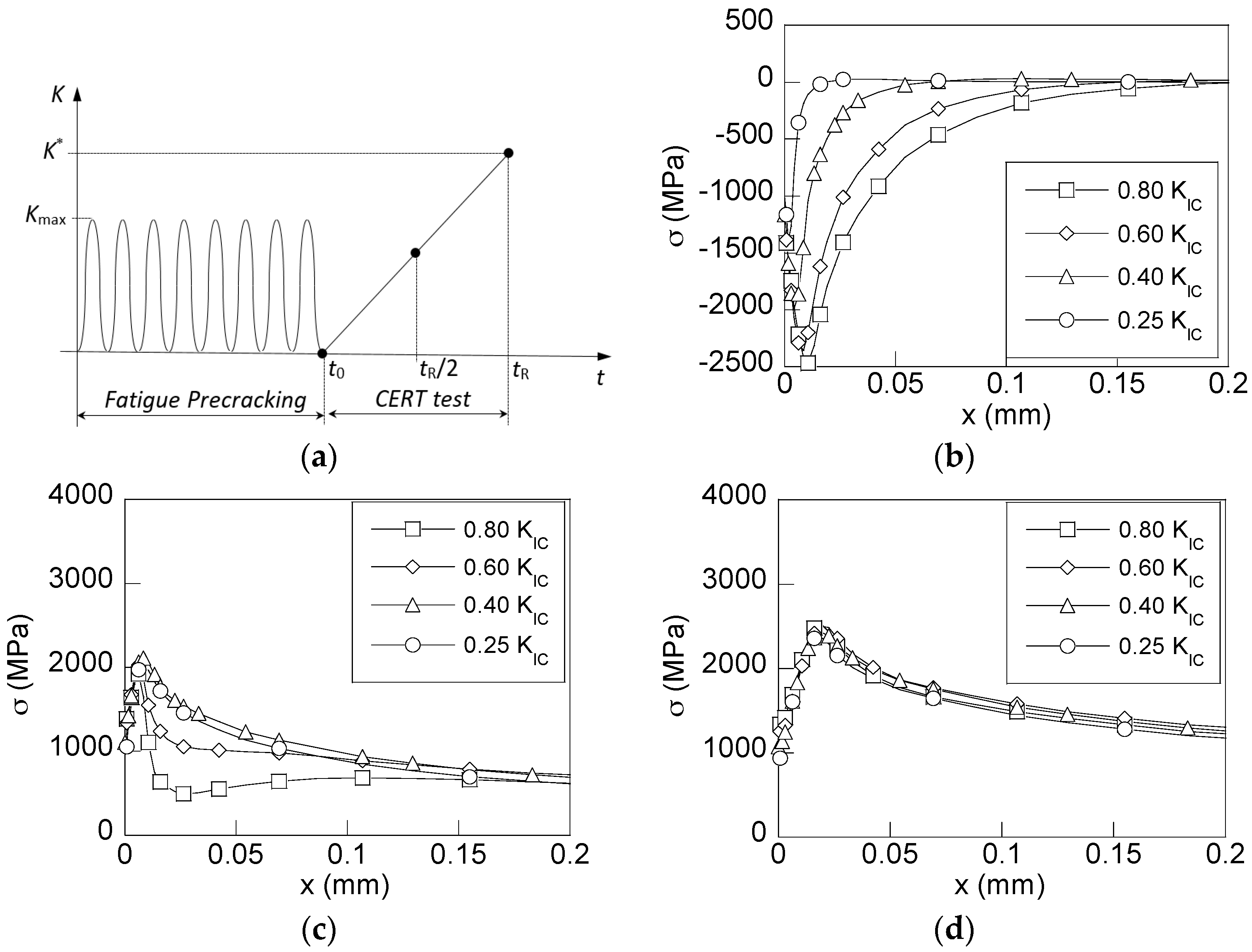
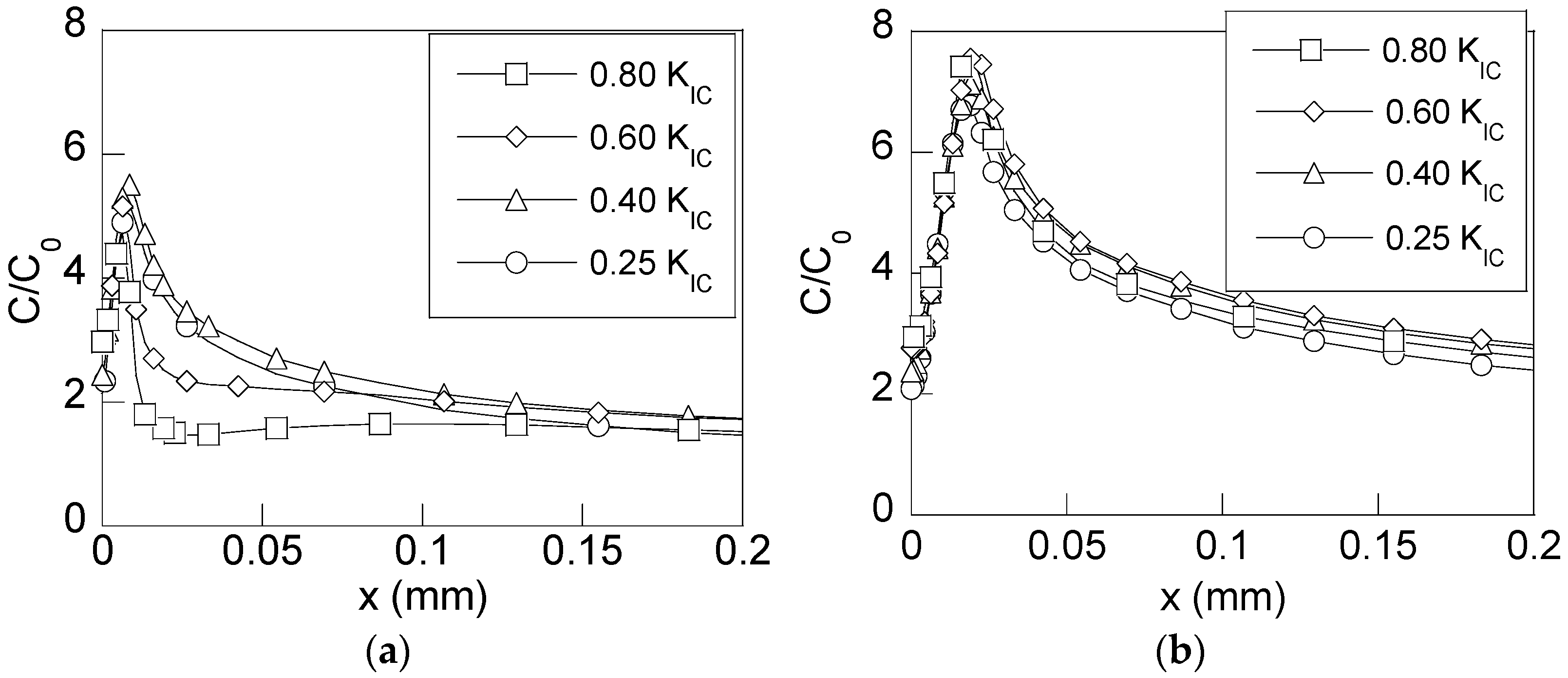
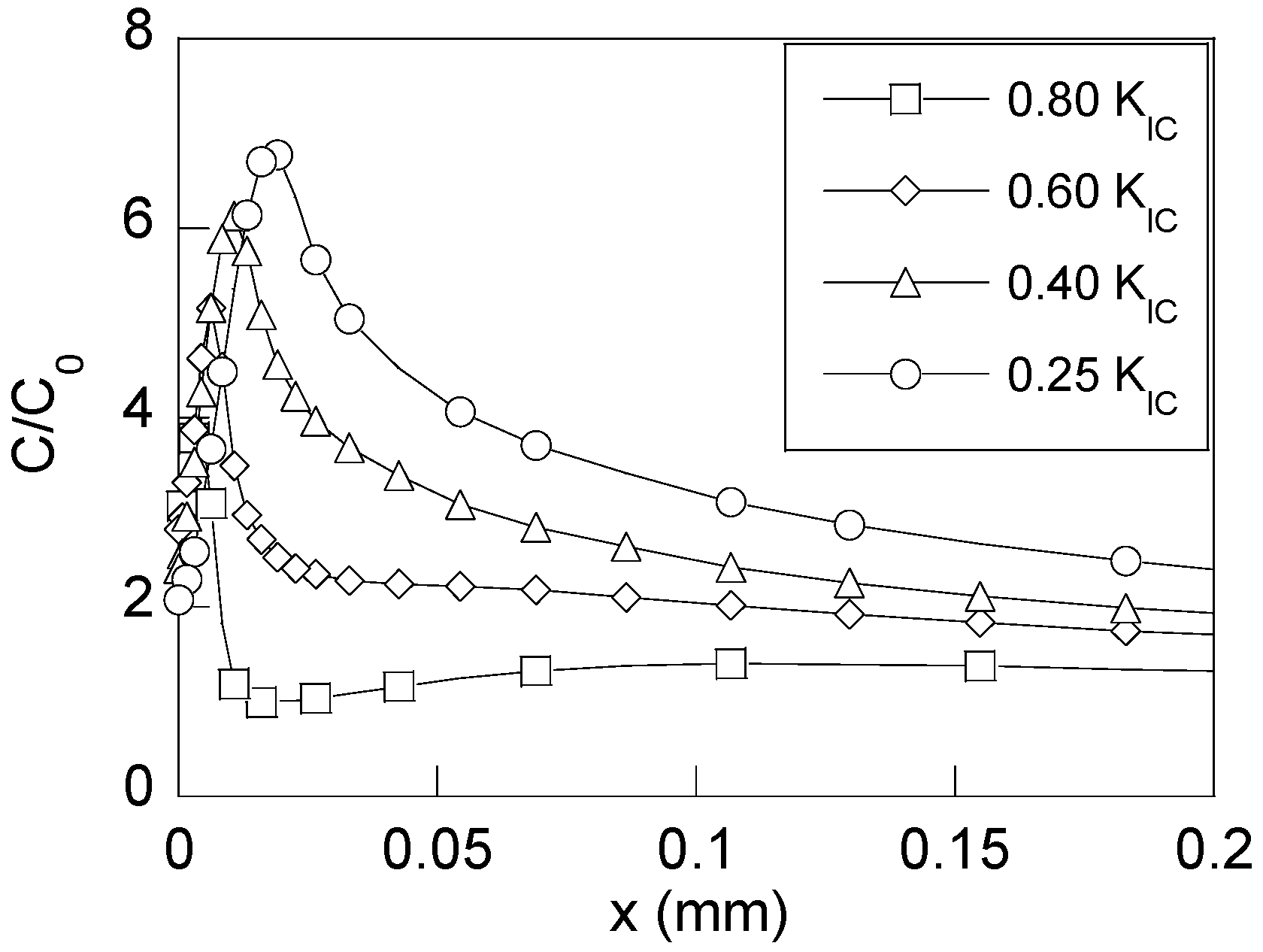
| E (GPa) | σY (GPa) | σR (GPa) | KIC (MPa·m1/2) |
|---|---|---|---|
| 202 | 0.696 | 1.224 | 52.8 |
| Kmax | tR (s) | FR (kN) |
|---|---|---|
| 0.80KIC | 22,900 | 48.1 |
| 0.60KIC | 21,600 | 44.0 |
| 0.40KIC | 21,000 | 38.3 |
| 0.25KIC | 17,000 | 31.3 |
© 2017 by the authors. Licensee MDPI, Basel, Switzerland. This article is an open access article distributed under the terms and conditions of the Creative Commons Attribution (CC BY) license (http://creativecommons.org/licenses/by/4.0/).
Share and Cite
Toribio, J.; Aguado, L.; Lorenzo, M.; Kharin, V. Hydrogen Assisted Cracking in Pearlitic Steel Rods: The Role of Residual Stresses Generated by Fatigue Precracking. Materials 2017, 10, 485. https://doi.org/10.3390/ma10050485
Toribio J, Aguado L, Lorenzo M, Kharin V. Hydrogen Assisted Cracking in Pearlitic Steel Rods: The Role of Residual Stresses Generated by Fatigue Precracking. Materials. 2017; 10(5):485. https://doi.org/10.3390/ma10050485
Chicago/Turabian StyleToribio, Jesús, Leticia Aguado, Miguel Lorenzo, and Viktor Kharin. 2017. "Hydrogen Assisted Cracking in Pearlitic Steel Rods: The Role of Residual Stresses Generated by Fatigue Precracking" Materials 10, no. 5: 485. https://doi.org/10.3390/ma10050485
APA StyleToribio, J., Aguado, L., Lorenzo, M., & Kharin, V. (2017). Hydrogen Assisted Cracking in Pearlitic Steel Rods: The Role of Residual Stresses Generated by Fatigue Precracking. Materials, 10(5), 485. https://doi.org/10.3390/ma10050485







